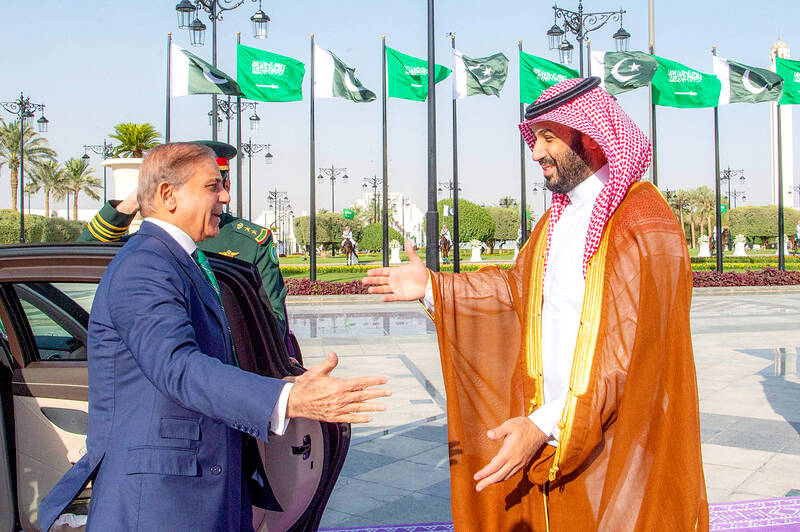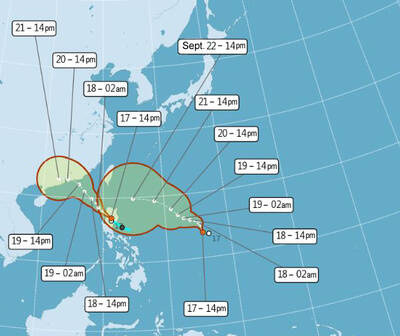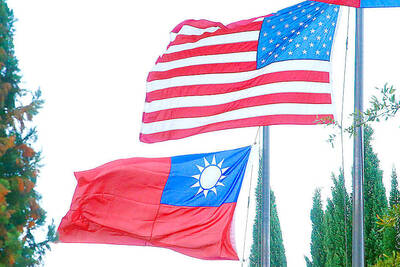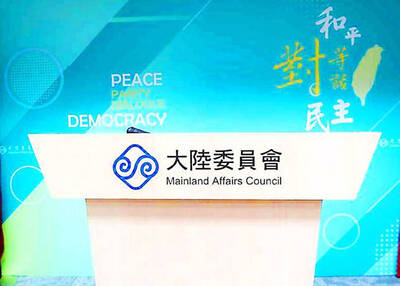Saudi Arabia and Pakistan on Wednesday signed a mutual defense pact that defines any attack on either nation as an attack on both.
The kingdom has long had close economic, religious and security ties with Pakistan, including reportedly providing funding for Islamabad’s nuclear weapons program as it developed.
Analysts — and Pakistani diplomats in at least one case — have suggested that Saudi Arabia could be included under Islamabad’s nuclear umbrella, particularly as tensions have risen over Iran’s atomic program.

Photo: AFP / HO / SPA
Saudi Arabian Crown Prince Mohammad bin Salman signed the pact with Pakistani Prime Minister Shehbaz Sharif.
While not specifically discussing nuclear weapons, the agreement states that “any aggression against either country shall be considered an aggression against both,” according to statements issued by the Pakistani Ministry of Foreign Affairs and the state-run Saudi Press Agency.
“This agreement ... aims to develop aspects of defense cooperation between the two countries and strengthen joint deterrence against any aggression,” the statement said.
A senior Saudi Arabian official, speaking on condition of anonymity to the Financial Times, seemed to suggest that Pakistan’s nuclear protection was a part of the deal, saying it “will utilize all defensive and military means deemed necessary depending on the specific threat.”
Zalmay Khalilzad, a former US diplomat with experience in Afghanistan and Pakistan, expressed concern over the deal, saying it comes in “dangerous times.”
“Pakistan has nuclear weapons and delivery systems that can hit targets across the Middle East, including Israel. It also is developing systems that can reach targets in the US,” Khalilzad wrote on social media.
Pakistan and Saudi Arabia have a defense relationship stretching back decades, in part due to Islamabad’s willingness to defend the Islamic holy sites of Mecca and Medina in the kingdom.
Pakistani troops first traveled to Saudi Arabia in the late 1960s over concerns about Egypt’s war in Yemen at the time.
Those ties increased after Iran’s 1979 Islamic Revolution and the kingdom’s fears of a confrontation with Tehran.
Pakistan developed its nuclear weapons program to counter India’s atomic bombs.
The two neighbors have fought multiple wars against each other and again came close to open warfare after an attack on tourists in April in Indian-controlled Kashmir.
India is estimated to have 172 nuclear warheads, while Pakistan has 170, according to the US-published Bulletin of Atomic Scientists.
The Indian Ministry of Foreign Affairs acknowledged the Saudi Arabia-Pakistan pact and said that it “will study the implications of this development for our national security as well as for regional and global stability.”
Saudi Arabia also has close ties with India.
Pakistan and Saudi Arabia did not respond to questions about whether the pact extended to Islamabad’s nuclear weapons arsenal.
Pakistan “has historically maintained a deliberately ambiguous nuclear doctrine,” the Bulletin of Atomic Scientists said.

Taiwan is projected to lose a working-age population of about 6.67 million people in two waves of retirement in the coming years, as the nation confronts accelerating demographic decline and a shortage of younger workers to take their place, the Ministry of the Interior said. Taiwan experienced its largest baby boom between 1958 and 1966, when the population grew by 3.78 million, followed by a second surge of 2.89 million between 1976 and 1982, ministry data showed. In 2023, the first of those baby boom generations — those born in the late 1950s and early 1960s — began to enter retirement, triggering

One of two tropical depressions that formed off Taiwan yesterday morning could turn into a moderate typhoon by the weekend, the Central Weather Administration (CWA) said yesterday. Tropical Depression No. 21 formed at 8am about 1,850km off the southeast coast, CWA forecaster Lee Meng-hsuan (李孟軒) said. The weather system is expected to move northwest as it builds momentum, possibly intensifying this weekend into a typhoon, which would be called Mitag, Lee said. The radius of the storm is expected to reach almost 200km, she said. It is forecast to approach the southeast of Taiwan on Monday next week and pass through the Bashi Channel

NO CHANGE: The TRA makes clear that the US does not consider the status of Taiwan to have been determined by WWII-era documents, a former AIT deputy director said The American Institute in Taiwan’s (AIT) comments that World War-II era documents do not determine Taiwan’s political status accurately conveyed the US’ stance, the US Department of State said. An AIT spokesperson on Saturday said that a Chinese official mischaracterized World War II-era documents as stating that Taiwan was ceded to the China. The remarks from the US’ de facto embassy in Taiwan drew criticism from the Ma Ying-jeou Foundation, whose director said the comments put Taiwan in danger. The Chinese-language United Daily News yesterday reported that a US State Department spokesperson confirmed the AIT’s position. They added that the US would continue to

The number of Chinese spouses applying for dependent residency as well as long-term residency in Taiwan has decreased, the Mainland Affairs Council said yesterday, adding that the reduction of Chinese spouses staying or living in Taiwan is only one facet reflecting the general decrease in the number of people willing to get married in Taiwan. The number of Chinese spouses applying for dependent residency last year was 7,123, down by 2,931, or 29.15 percent, from the previous year. The same census showed that the number of Chinese spouses applying for long-term residency and receiving approval last year stood at 2,973, down 1,520,